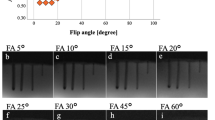Abstract
Purpose
For two types of passively visualizable magnetic resonance (MR)-compatible needles, the size of susceptibility artifacts was investigated at 0.2 and 1.5 Tesla (T) and assessed regarding their suitability for needle visualization.
Methods
Phantom trials were performed using T1-weighted spin echo (SE), turbospin echo (TSE) and gradient echo (GE) sequences and different angles β between the needles and the main magnetic field (B0).
Results
Depending on the needle angle β and the applied pulse sequence, we found artifact diameters of 0–9.7 mm employing SE, of 1.7–9.4 mm employing TSE, and of 1.4–20.6 mm employing GE at 1.5 T. At 0.2 T, we found artifact diameters of 0–5.7 mm employing SE, of 0–6.3 mm employing TSE, and of 0–11.3 mm employing GE.
Conclusion
Comparing artifact sizes at 1.5T and 0.2 T, low field strength is superior for passive visualization of the needles tested—especially if GE imaging is performed.
Similar content being viewed by others
References
Duckwiler G, Lufkin RB, Teresi L, Spickler E, Dion J, Vinuela F, Bentson J, Hanafee W (1989) Head and neck lesions: MR-guided aspiration biopsy. Radiology 170:519–522
Fischer U, Vosshenrich R, Keating D, Bruhn H, Döler W, Oestmann JW, Grabbe E (1994) MR-guided biopsy of suspect breast lesions with a simple stereotaxic add-on device for surface coils. Radiology 192:272–273
Lufkin R, Teresi L, Hanafee W (1987) New needle for MR-guided aspiration cytology of the head and neck. AJR 149:380–382
Lufkin R, Layfield L (1989) Coaxial needle system of MR- and CT-guided aspiration cytology. J Comput Assist Tomogr 13: 1105–1107
Mueller PR, Stark DD, Simeone JF, Saini S, Butch RJ, Edelman RR, Wittenberg J, Ferrucci JT (1986) MR-guided aspiration biopsy: Needle design and clinical trials. Radiology 161:605–609
Wesbey G, Edelman RR, Harris R (1990) Artifacts in MR-imaging: Description, causes, and solutions. In: Edelman RR, Hesselink JR (eds) Clinical Magnetic Resonance Imaging. WB Saunders, Philadelphia, pp 74–108
Hendrick RE, Russ, PD, Simon JH (1993) MRI: Principles and Artifacts. Raven Press, New York, pp 144–179
Lufkin R, Teresi L, Chiu L, Hanafee W (1988) A technique for MR-guided needle placement. AJR 151:193–196
New PFJ, Rosen BR, Brady TJ, Buonanno FS, Kistler JP, Burt CT, Hinshaw WS, Newhouse JH, Pohost GM, Taveras JM (1983) Potential hazards and artifacts of ferromagnetic and nonferromagnetic surgical and dental materials and devices in nuclear magnetic resonance imaging. Radiology 147:139–148
Author information
Authors and Affiliations
Rights and permissions
About this article
Cite this article
Frahm, C., Gehl, HB., Melchert, U.H. et al. Visualization of magnetic resonance-compatible needles at 1.5 and 0.2 Tesla. Cardiovasc Intervent Radiol 19, 335–340 (1996). https://doi.org/10.1007/BF02570186
Issue Date:
DOI: https://doi.org/10.1007/BF02570186




